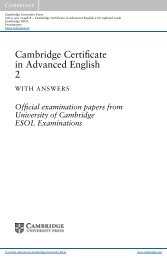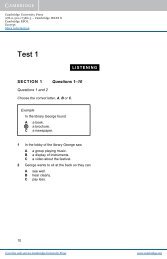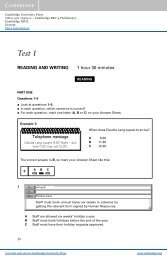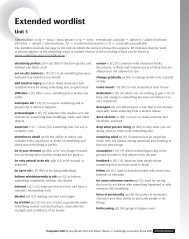Chapter 1 - Assets - Cambridge University Press
Chapter 1 - Assets - Cambridge University Press
Chapter 1 - Assets - Cambridge University Press
Create successful ePaper yourself
Turn your PDF publications into a flip-book with our unique Google optimized e-Paper software.
<strong>Cambridge</strong> <strong>University</strong> <strong>Press</strong>978-0-521-73830-9 - Physics 2 for OCRGurinder Chadha and David SangExcerptMore information<strong>Chapter</strong> 1: MomentumModelling collisionsSpringy collisionsFigure 1.3a shows what happens when one snookerball collides head-on with a second, stationary ball.The result can seem surprising. The moving ball stopsdead. The ball initially at rest moves off with thesame velocity as that of the original ball. To achievethis, a snooker player must observe two conditions:The collision must be head-on. (If one ball strikesa glancing blow on the side of the other, they willboth move off at different angles.)The moving ball must not be given any spin. (Spinis an added complication which we will ignore inour present study, although it plays a vital part inthe game of snooker.)aFigure 1.2 If you play snooker often enough, youwill be able to predict how the balls will move on thetable. Alternatively, you can use the laws of physicsto predict their subsequent motion.b2a hockey stick strikes a ball a comet or an asteroid collides with a planet as itorbits the Sunthe atoms of the air collide constantly with eachother, and with the walls of their surroundingselectrons that form an electric current collide withthe vibrating ions that make up a metal wiretwo distant galaxies collide over millions of years.From these examples, we can see that collisions arehappening all around us, all the time. They happenon the microscopic scale of atoms and electrons, theyhappen in our everyday world, and they also happenon the cosmic scale of our universe.Figure 1.3 a One snooker ball hits another head-on.b You can do the same thing with two trolleys inthe laboratory.You can mimic the collision of the snooker ballsin the laboratory, using two identical trolleys, asshown in Figure 1.3b. The moving trolley has itsspring-load released, so that the collision is springy.compressed, and then it pushes out again to set thecomplete halt. The ‘motion’ of one trolley has beentransferred to the other.© <strong>Cambridge</strong> <strong>University</strong> <strong>Press</strong> www.cambridge.org
<strong>Cambridge</strong> <strong>University</strong> <strong>Press</strong>978-0-521-73830-9 - Physics 2 for OCRGurinder Chadha and David SangExcerptMore information<strong>Chapter</strong> 1: MomentumYou can see another interesting result if twomoving identical trolleys collide head-on. If thecollision is springy, both trolleys bounce backwards.If a fast-moving trolley collides with a slower one,the fast trolley bounces back at the speed of the slowone, and the slow one bounces back at the speed ofthe fast one. In this collision, it is as if the velocitiesof the trolleys have been swapped.Sticky collisionsFigure 1.4 shows another type of collision. In thiscase, the trolleys have adhesive pads so that they sticktogether when they collide. A sticky collision likethis is the opposite of a springy collision like the onesdescribed above.SAQ1 Here are two collisions to picture in your mind.Answer the question for each.a Ball A, moving towards the right, collideswith stationary ball B. Ball A bounces back;B moves off slowly to the right. Which has agreater mass, A or B?b Trolley A, moving towards the right, collideswith stationary trolley B. They stick together,and move off slower than halfA’s original speed. Which hasAnswerthe greater mass, A or B?From the examples discussed above, we can seethat two quantities are important in understandingcollisions:massm of the objectvelocityv of the object.These are combined to give a single quantity, calledthe linear momentum (or simply momentum) p ofas the product of the mass of the object and itsvelocity. Hence:momentum = mass velocityp = mvFigure 1.4 If a moving trolley sticks to a stationarytrolley, they both move off together.If a single moving trolley collides with a singlestationary one, they both move off together. Afterthe collision, the speed of the combined trolleys ishalf that of the original trolley. It is as if the ‘motion’of the original trolley has been shared between thetwo. If a single trolley collides with a double one(twice the mass), they move off with one-third of theoriginal velocity.From these examples of sticky collisions, you cansee that, when the mass of the trolley increases as aresult of a collision, its velocity decreases. Doublingthe mass halves the velocity, and so on.The unit of momentum is kg m s . There is nospecial name for this unit in the SI system.Momentum is a vector quantity because it is aproduct of a vector quantity (velocity) and a scalarquantity (mass). Momentum has both magnitudeand direction. Its direction is the same as thedirection of the object’s velocity.In the earlier examples, we described how the‘motion’ of one trolley appeared to be transferredto a second trolley, or shared with it. It is morecorrect to say that it is the trolley’s momentumthat is transferred or shared. (Strictly speaking, weshould refer to linear momentum, because there isanother quantity called angular momentum, which ispossessed by spinning objects.)3© <strong>Cambridge</strong> <strong>University</strong> <strong>Press</strong> www.cambridge.org
<strong>Cambridge</strong> <strong>University</strong> <strong>Press</strong>978-0-521-73830-9 - Physics 2 for OCRGurinder Chadha and David SangExcerptMore information<strong>Chapter</strong> 1: Momentumconserved. We have to consider objects which forma closed system – that is, no external force acts onthem. The principle of conservation of momentumstates that:Within a closed system, the total momentum inThe principle of conservation of momentum can alsobe expressed as follows:total momentum of objects before collision= total momentum of objects after collisionA group of colliding objects always has as muchmomentum after the collision as it had beforethe collision. This principle is illustrated inWorked example 1.Worked example 1In Figure 1.5, trolley A of mass 0.80 kg travellingat a velocity of 3.0 m s collides head-on witha stationary trolley B. Trolley B has twice themass of trolley A. The trolleys stick together andhave a common velocity of 1.0 m s after thecollision. Show that momentum is conserved inthis collision.beforepositivedirectionafteru A = 3.0 m s –1 u B = 0 v A+B = 1.0 m s –1A 0.80 kg B A 0.80 kg B0.80 kg 0.80 kg 0.80 kg 0.80 kgStep 1 Make a sketch using the information givenin the question. Notice that we need two diagramsto show the situations before and after the collision.Similarly, we need two calculations – one for themomentum of the trolleys before the collision andone for their momentum after the collision.Step 2 Calculate the momentum before thecollision:momentum of trolleys before collision= m A u A + m B u B= (0.80 3.0) + 0= 2.4 kg m s The trolley B has no momentum before thecollision, because it is not moving.Step 3 Calculate the momentum after the collision:momentum of trolleys after collision= (m A + m B ) v A+B= (0.80 + 1.60) 1.0= 2.4 kg m s So, both before and after the collision, the trolleyshave a combined momentum of 2.4 kg m s –1 .Momentum has been conserved.SAQ2 Calculate the momentum of each of the followingobjects:a A 0.50 kg stone travelling at a velocity of 20 m s .b A 25-tonne bus travelling at20 m s Hinton a road.c An electron travelling at 2.0 10 7 m s .The mass of the electron is9.1 10 Answerkg.4Figure 1.5 The state of the trolleys A and B,before and after the collision.continued3Two balls, each of mass 0.50 kg,Hintcollide as shown in Figure 1.6.Show that their total momentum beforethe collision is equal to their totalAnswermomentum after the collision.© <strong>Cambridge</strong> <strong>University</strong> <strong>Press</strong> www.cambridge.org
<strong>Cambridge</strong> <strong>University</strong> <strong>Press</strong>978-0-521-73830-9 - Physics 2 for OCRGurinder Chadha and David SangExcerptMore information<strong>Chapter</strong> 1: Momentumbeforeafter2.0 m s –1 2.0 m s –1 1.0 m s –1A B A BFigure 1.6 For SAQ 3.Motor manufacturers make use of test labs toinvestigate how their cars respond to impacts. Whena car is designed, the manufacturers combine soft,compressible materials that absorb energy withrigid structures that protect the car’s occupants.Old-fashioned cars had much more rigid structures.In a collision, they were more likely to bounce backand the violent forces involved were much morelikely to prove fatal.3.0 m s –1 v v v vUnderstanding collisionsThe cars in Figure 1.7 have been badly damaged by acollision. The front of a car is designed to absorb theimpact of the crash. It has a ‘crumple zone’, whichcollapses on impact. This absorbs most of the kineticenergy that the car had before the collision. It is betterthat the car’s kinetic energy should be transferred tothe crumple zone than to the driver and passengers.Two types of collisionWhen two objects collide, they may crumple anddeform. Their kinetic energy may also disappearcompletely and they come to a halt. This is anexample of an inelastic collision. Alternatively, theymay spring apart, retaining all of their kinetic energy.This is a perfectly elastic collision. In practice, inmost collisions, some kinetic energy is transformedinto other forms (e.g. heat or sound) and the collisionis inelastic. Previously we described the collisions asbeing ‘springy’ or ‘sticky’. We should now use theperfectly elastic and inelastic.We will look at examples of these two typesof collision and consider what happens to linearmomentum and kinetic energy in each.A perfectly elastic collisionTwo identical objects A and B, moving at the samespeed but in opposite directions, have a head-oncollision, as shown in Figure 1.8. This is a perfectlyelastic collision. Each object bounces back with itsvelocity reversed.beforepositivedirectionafterA B A BmmmmFigure 1.7 The front of each car has crumpled in, asa result of a head-on collision.Figure 1.8 Two objects may collide in differentways: this is an elastic collision. An inelastic collisionof the same two objects is shown in Figure 1.9.5© <strong>Cambridge</strong> <strong>University</strong> <strong>Press</strong> www.cambridge.org
<strong>Cambridge</strong> <strong>University</strong> <strong>Press</strong>978-0-521-73830-9 - Physics 2 for OCRGurinder Chadha and David SangExcerptMore information<strong>Chapter</strong> 1: MomentumYou should be able to see that, in this collision,both momentum and kinetic energy are conserved.Before the collision, we have an object A of massm moving to the right at speed v and an object B ofmass m moving to the left at speed v. Afterwards, wehave the same, but now object A is moving to the left,and object B is moving to the right.Mathematically, we can express this as follows:Before the collisionObject Amass = mvelocity = vmomentum = mvObject Bmass = mvmvSo the total momentum and the total kinetic energyare unchanged. They are both conserved in a perfectlyelastic collision such as this.An inelastic collisionIn Figure 1.9, the same two objects collide, but thistime they stick together after the collision and cometo a halt. Clearly, the total momentum and the totalkinetic energy are both zero after the collision, sinceneither mass is moving. We have:Before collision After collisionmomentum 0 0kinetic energy mv 2 0The object B has negative velocity and momentumbecause it is travelling in the opposite direction toobject A.Therefore we have:total momentum before collision= momentum of A + momentum of B= mv + (–mv) = 0total kinetic energy before collision= KE of A + KE of B= 1 2 mv2 + 1 2 mv2 = mv 2The magnitude of the momentum of each object is thesame. Momentum is a vector quantity and we haveto consider the directions in which the objects travel.The combined momentum is zero. On the otherhand, kinetic energy is a scalar quantity and directionof travel is irrelevant. Both objects have the samekinetic energy and therefore the combined kineticenergy is twice the kinetic energy of a single object.After the collisionBoth objects have their velocities reversed, andwe have:Atotal momentum after collision= (–mv) + mv = 0total kinetic energy after collision= 1 2 mv2 + 1 2 mv2 = mv 2mvbeforevmpositivedirectionafterB A Bm mFigure 1.9 An inelastic collision between twoidentical objects.Again we see that momentum is conserved here.However, kinetic energy is not conserved. It is lostbecause work is done in deforming the two objects.In fact, momentum is always conserved inall collisions. There is nothing else into whichmomentum can be converted. Kinetic energy isusually not conserved in a collision, because it canbe transformed into other forms of energy – soundenergy if the collision is noisy, and the energyinvolved in deforming the objects (which usuallyends up as heat – they get warmer). Of course, thetotal amount of energy remains constant as prescribedby the principle of conservation of energy.6© <strong>Cambridge</strong> <strong>University</strong> <strong>Press</strong> www.cambridge.org
<strong>Cambridge</strong> <strong>University</strong> <strong>Press</strong>978-0-521-73830-9 - Physics 2 for OCRGurinder Chadha and David SangExcerptMore information<strong>Chapter</strong> 1: MomentumSAQ4 Copy the table below, choosing the correct words from each pair.Type of collision Momentum Kinetic energy Total energyperfectly elastic conserved /not conservedinelastic conserved /not conservedconserved /not conservedconserved /not conservedconserved /not conservedconserved /not conservedAnswerSolving collision problemsWe can use the idea of conservation of momentum to solvenumerical problems, as illustrated by Worked example 2.Worked example 2In the game of bowls, a player rolls a large balltowards a smaller, stationary ball. A large ball of mass5.0 kg moving at 10.0 m s –1 strikes a stationary ball of –1 .a after the impact.b Calculate the kinetic energy ‘lost’ in the impact.Step 1 Draw two diagrams, showing the situationsbefore and after the collision. Figure 1.10 shows thevalues of masses and velocities; since we don’t knowthe velocity of the large ball after the collision, this isshown as v. The direction from left to right has beenassigned ‘positive direction’.Step 2 Using the principle of conservation ofmomentum, set up an equation and solve for thevalue of v:total momentum before collision= total momentum after collision(5.0 10) + (1.0 0) = (5.0 v) + (1.0 10)50 + 0 = 5.0v + 10v = 40 = 8.0 m s–15.0So the speed of the large ball decreases to 8.0 m s –1after the collision. Its direction of motion isunchanged – the velocity remains positive.beforeafterpositivedirection10 m s –1 v5.0 kg 1.0 kg 5.0 kg 1.0 kgStep 3 calculate the change in kinetic energy duringthe collision:total KE before collision= 1 2 5.0 102 + 0 = 250 Jtotal KE after collision= 1 5.0 2 8.02 1+ 1.0 2 102 = 210 JKE ‘lost’ in the collision= 250 J 210 J = 40 J10 m s –1Figure 1.10 When solving problems involvingcollisions, it is useful to draw diagrams showing thesituations before and after the collision. Include thevalues of all the quantities that you know.This lost kinetic energy will appear as heat energy(the two balls get warmer) and as sound energy (wehear the collision between the balls).7© <strong>Cambridge</strong> <strong>University</strong> <strong>Press</strong> www.cambridge.org
<strong>Cambridge</strong> <strong>University</strong> <strong>Press</strong>978-0-521-73830-9 - Physics 2 for OCRGurinder Chadha and David SangExcerptMore information<strong>Chapter</strong> 1: MomentumThe astronaut shown in Figure 1.13 is on a‘space walk’. A cable tethers him to the Shuttle. Toreturn to the craft, he pulls on the tether. This giveshim some momentum towards the spacecraft, andhe moves gently back to it.Where does this momentum come from? Has it beencreated out of nothing? The astronaut gives himselfmomentum towards the spacecraft by tugging on thetether. At the same time, his tug pulls on the spacecraftand causes it to accelerate towards him. The spacecraftgains momentum towards the astronaut. These twomomenta must be equal and opposite, so that theirsum is zero; otherwise the astronaut really will havecreated momentum out of nothing. The astronaut has asmall mass, and moves relatively quickly towards thespacecraft. The spacecraft’s mass is much greater, andso its velocity must be much smaller.Here is another momentum problem for anastronaut. Suppose he is working with tools on theoutside of the craft, and then realises that his tetherhas snapped. How can he get back to the craft?He wants to have some momentum towards thespacecraft, so he must create some momentumaway from it as well. The solution is to throw oneof his tools out into space. It has momentum awayFigure 1.13 Astronauts often carry out ‘space walks’,when they leave the shuttle to work outside. Theyhave a tether so that they don’t drift off into space.from the spacecraft, so he has momentum towardsthe spacecraft.Fortunately, astronauts now usually wearbackpacks with ‘Manned Manoeuvring Units’attached. These are rocket-powered units whichallow the astronaut to move around. The rocketblasts a jet of gas into space; this gives theastronaut momentum in the opposite direction.SAQ7 An astronaut of mass 100 kg is adrift in space.He is 10.0 m from his spacecraft. To get back, hethrows a spanner of mass 1.0 kg directly awayfrom the craft at a speed of 5.0 m s .a Explain why he moves back towardsthe spacecraft.b Calculate how long it will takeAnswerhim to reach the spacecraft.8A ball of mass 0.40 kg is thrown at a wall.It strikes the wall with a speed of 1.5 m s perpendicular to the wall and bounces off thewall with a speed of 1.2 m s .Explain the changes in momentum and energywhich happen in the collision between the balland the wall. Give numericalAnswervalues where possible.Explosions and crash-landingsThe rockets shown in Figure 1.14 rise high into thesky. As they start to fall, they send out showers ofchemical packages, each of which explodes to produceout in all directions to create a spectacular effect.Does an explosion create momentum out of nothing?The important point to note here is that the burningmaterial spreads out equally in all directions. Eachtiny spark has momentum, but for every spark, thereis another moving in the opposite direction, i.e. withopposite momentum. Since momentum is a vectorquantity, the total amount of momentum created is zero.At the same time, kinetic energy is created in anenergy has come from the chemical potential energystored in the chemical materials before they burn.9© <strong>Cambridge</strong> <strong>University</strong> <strong>Press</strong> www.cambridge.org
















